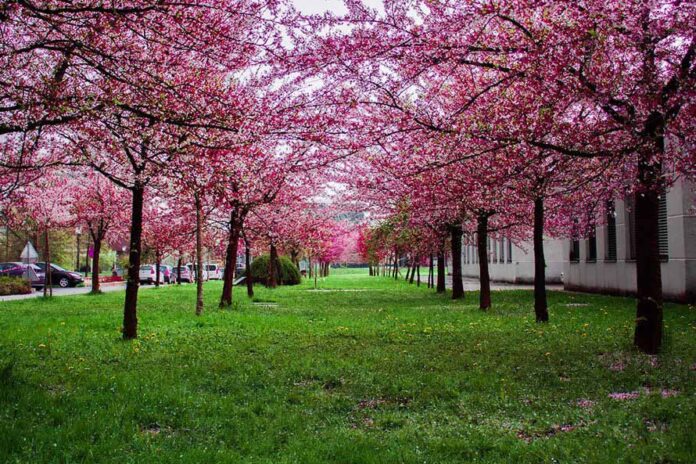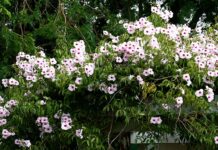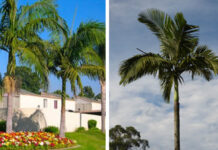
Cherry trees are renowned for their exquisite blossoms, delectable fruit, and breathtaking autumn foliage. Popular among homeowners who wish to add a touch of natural beauty to their landscape. These trees are generally low maintenance, but there are a few things you should know before planting one.
This page will cover everything you need to know about these incredible trees, including their various kinds, planting instructions, maintenance requirements, and common pests and illnesses.
Varieties of Cherry Trees
There are two primary varieties of cherry trees: sweet cherries and sour cherries. Tart cherries are typically used in cooking and baking, while sweet cherries are typically consumed fresh. Within each kind, there are a variety of options available. Popular types of sweet cherries include Bing, Rainier, and Black Tartarian. Prominent types of sour cherry include Montmorency, Morello, and Balaton.
Sweet Cherries
Prunus avium, often known as sweet cherries, is the most common kind of cherry tree. Its flesh is solid and juicy, and they have a pleasant flavor. There are numerous colors of sweet cherry, including red, yellow, and black. The most prevalent varieties of sweet cherries are Bing, Rainier, and Lambert.
Acidic Cherries
Tart cherries, also known as Prunus cerasus, are more sour and smaller than their sweet counterparts. They are frequently used in baking, canning, and the production of cherry juice. Tart cherries are often dark red or black in color and possess a mildly sour taste. Montmorency and Morello are popular types of tart cherry.
Dwarf Cherry Trees
Dwarf cherry trees are small and compact, making them excellent for small gardens and containers. They produce fruit of the same size and flavor, but require less land. Stella, Compact Stella, and Lapins are types of dwarf cherry tree.
Ornamental Cherry Trees
Ornamentals, also known as flowering cherry trees, are cultivated for their beautiful springtime blossoms rather than their fruit. They produce stunning pink or white flowers and are often used for landscaping and ornamental purposes. Yoshino, Kwanzan, and Weeping Cherry are popular decorative cherry tree cultivars.
Hybrid Cherry Trees
Several types are crossed to produce hybrid cherry trees. They generate a superior tree by combining the beneficial characteristics of their parent trees, such as disease resistance and fruit size. Utah Giant, Black Gold, and Royalton are all popular hybrid cherry tree cultivars.
Consider the specific growing requirements of your region, such as climate and soil type, as well as the tree’s size and fruit features when choosing a cherry tree variety to plant. With so many varieties available, you are certain to find one that meets your needs.
Planting Cherry Trees
These amazing trees are a lovely and profitable addition to any garden or orchard. They are generally simple to cultivate and maintain, but appropriate planting is necessary for optimal development and fruit output.
This section will provide a comprehensive guide on planting and caring for cherry trees, including site selection, soil preparation, and tree maintenance.
Site Selection
Choosing the proper spot is essential for the success of your cherry tree. These trees need full sun and well-drained soil. They prefer soil with a pH range between 6.0 and 6.6. Avoid growing those trees in low-lying regions where cold air might condense and cause harm from frost.
Soil Preparation
Before planting, it is necessary to adequately prepare the soil. Begin by clearing the planting location of any grass, weeds, or rubbish. If your soil is thick and compacted, consider adding organic matter such as compost or old manure to enhance soil structure and drainage. Ch. trees prefer loose, well-draining soil.
Tree Planting
Should be planted in early spring, when the soil has warmed and the danger of frost has passed. Create a hole that is twice as big and just as deep as the root ball.
Place the tree in the hole, ensuring that the graft union (the swelling area where the rootstock joins the scion) is above the ground. Fill the hole with soil and lightly compact it to eliminate air pockets.
Watering and Fertilization
Watering and Fertilizing: After planting, properly water the tree to help settle the soil around its roots. Maintaining a wet but not soggy soil throughout the first year of the tree’s life is essential.
Regular fertilizer is beneficial, especially throughout the growing season. Use a balanced fertilizer, such as a 10-10-10, as directed by the manufacturer.
Pruning and Training
Pruning is necessary for the health and yield of your cherry tree. In late winter or early spring, prune the tree to remove any diseased or dead branches and increase air circulation.
Depending on your desire and growing conditions, these can be trained into a center leader or an open vase shape.
By according to these instructions, you may assure a healthy and fruitful cherry tree. Remember to keep an eye out for pests and illnesses, and supply the tree with enough water and nutrients. With appropriate care and attention, your cherry tree will provide delicious fruit and gorgeous flowers for years to come.
Caring for Cherry Trees
After planting a cherry tree, it is essential to provide regular maintenance to maintain good growth and fruit output. Regular watering is necessary, especially during dry periods. In addition, a layer of mulch around the tree’s base will help retain moisture.
Annual pruning is necessary to eliminate unhealthy or diseased wood as well as any branches that cross. This enhances ventilation and helps avoid disease. Before the tree buds in late winter or early spring, pruning should be performed.
To encourage healthy growth and fruit production, these must be fertilized. In early spring and again in late summer, a balanced fertilizer should be administered.
Cherry Trees Common Pests and Diseases
Cherry trees are subject to a number of pests and illnesses that can have negative effects on their development, productivity, and overall health. In this section, we will review the most prevalent pests and diseases affecting these trees and offer advice on how to prevent and control them.
Pests
- Cherry Fruit Fly: The cherry fruit fly is a widespread pest that can cause considerable harm to cherry produce. The adult flies lay their eggs on the fruit, which develop into flesh-eating larvae. Use sticky traps to monitor the population and spray insecticides according to the manufacturer’s instructions to prevent infestation.
- Aphids: Aphids are little insects with soft bodies that feed on the sap. These can result in stunted growth, twisted leaves, and diminished fruit output. Spray the tree with a strong stream of water to dislodge the aphids, or use insecticidal soap.
- Spider mites: Spider mites are small bugs that eat on the underside of leaves, causing them to yellow and drop off. Spray the tree with water to remove the mites or use a miticide to treat spider mites.
Diseases:
-
- Brown Rot: Brown rot is a fungal disease that causes decay and rot in cherry fruit. To prevent brown rot, implement proper sanitation by removing and discarding infected fruit and by cutting infected branches.
- Leaf Spot: Leaf spot is a fungus that forms circular patches on the leaves. To avoid leaf spot, remove affected leaves and branches and apply fungicides per the instructions on the product label.
- Powdery Mildew: This fungal disease forms a white, powdery coating on the leaves and stems of cherry trees. Plant your trees in regions with sufficient air circulation and spray fungicides as needed to prevent powdery mildew.
These are best protected from pests and diseases by preventative measures. Observe proper cleanliness by eliminating infected plant debris and by frequently inspecting the tree for symptoms of pests and illnesses. If you discover a problem, take swift action to avoid its spread to other sections of the tree or to other trees in your orchard. You can maintain your cherry tree healthy and productive for many years with regular care and maintenance.
FAQs:
Q: How long does it take for a cherry tree to produce fruit?
A: Most of these trees require between three and five years to bear fruit, however certain kinds may take longer.
Q: Can cherry trees grow in pots?
A: Sure, can be planted in containers; nevertheless, they require careful watering and fertilization.
Q: What is the best time of year to plant a cherry tree?
A: The optimal time to plant a cherry tree is in late winter or early spring, prior to the tree’s budding.







![Rose Names And All Rose Types – The Most Detailed Guide [2022] rose names](https://www.yardious.com/wp-content/uploads/2018/05/rose-names-100x70.jpg)











